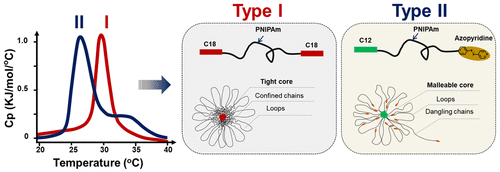当前位置:
X-MOL 学术
›
Macromolecules
›
论文详情
Our official English website, www.x-mol.net, welcomes your
feedback! (Note: you will need to create a separate account there.)
The Two Phase Transitions of Hydrophobically End-Capped Poly(N-isopropylacrylamide)s in Water.
Macromolecules ( IF 5.1 ) Pub Date : 2020-06-25 , DOI: 10.1021/acs.macromol.0c00487 Hao Ren 1 , Xing-Ping Qiu 2 , Yan Shi 3 , Peng Yang 1 , Françoise M Winnik 4, 5, 6
Macromolecules ( IF 5.1 ) Pub Date : 2020-06-25 , DOI: 10.1021/acs.macromol.0c00487 Hao Ren 1 , Xing-Ping Qiu 2 , Yan Shi 3 , Peng Yang 1 , Françoise M Winnik 4, 5, 6
Affiliation

|
High-sensitivity differential scanning calorimetry (HS-DSC) thermograms of aqueous poly(N-isopropylacrylamide) (PNIPAM) solutions present a sharp unimodal endotherm that signals the heat-induced dehydration/collapse of the PNIPAM chain. Similarly, α,ω-di-n-octadecyl-PNIPAM (C18-PN-C18) aqueous solutions exhibit a unimodal endotherm. In contrast, aqueous solutions of α,ω-hydrophobically modified PNIPAMs with polycyclic terminal groups, such as pyrenylbutyl (Py-PN-Py), adamantylethyl (Ad-PN-Ad), and azopyridine- (C12-PN-AzPy) moieties, exhibit bimodal thermograms. The origin of the two transitions was probed using microcalorimetry measurements, turbidity tests, variable temperature 1H NMR (VT-NMR) spectroscopy, and 2-dimensional NOESY experiments with solutions of polymers of molar mass (Mn) from 5 to 20 kDa and polymer concentrations of 0.1 to 3.0 mg/mL. The analysis outcome led us to conclude that the difference of the thermograms reflects the distinct self-assembly structures of the polymers. C18-PN-C18 assembles in water in the form of flower micelles held together by a core of tightly packed n-C18 chains. In contrast, polymers end-tagged with azopyridine, pyrenylbutyl, or adamantylethyl form a loose core that allows chain ends to escape from the micelles, to reinsert in them, or to dangle in surrounding water. The predominant low temperature (T1) endotherm, which is insensitive to polymer concentration, corresponds to the dehydration/collapse of PNIPAM chains within the micelles, while the higher temperature (T2) endotherm is attributed to the dehydration of dangling chains and intermicellar bridges. This study of the two phase transitions of telechelic PNIPAM homopolymer highlights the rich variety of morphologies attainable via responsive hydrophobically modified aqueous polymers and may open the way to a variety of practical applications.
中文翻译:

疏水端基封端的聚(N-异丙基丙烯酰胺)在水中的两相转变。
聚(N-异丙基丙烯酰胺)(PNIPAM)水溶液的高灵敏度差示扫描量热法(HS-DSC)热谱图显示了尖锐的单峰吸热,表明PNIPAM链因热引起的脱水/塌陷。类似地,α,ω-二正十八烷基-PNIPAM(C18-PN-C18)水溶液表现出单峰吸热。相反,具有多环端基的α,ω-疏水改性的PNIPAM的水溶液,例如pyr丁基(Py-PN-Py),金刚烷基乙基(Ad-PN-Ad)和偶氮吡啶-(C12-PN-AzPy)部分,展示双峰热分析图。使用微量量热法,浊度测试,可变温度1探测了两个转变的起源1 H NMR(VT-NMR)光谱和二维NOESY实验,其中摩尔质量(M n)为5至20 kDa的聚合物和聚合物浓度为0.1至3.0 mg / mL的溶液。分析结果使我们得出结论,热谱图的差异反映了聚合物独特的自组装结构。C18-PN-C18以花朵胶束的形式在水中组装,这些胶束由紧密堆积的n -C18链的核心固定在一起。相比之下,被偶氮吡啶,噻吩基丁基或金刚烷基乙基末端标记的聚合物形成一个松散的核,该核使得链端可以从胶束中逸出,重新插入其中或在周围的水中悬挂。低温(T 1对聚合物浓度不敏感的吸热对应于胶束中PNIPAM链的脱水/塌陷,而较高的温度(T 2)吸热则归因于悬空链和胶束间桥的脱水。对远螯PNIPAM均聚物的两个相变的研究突出了通过响应性疏水改性的水性聚合物可获得的多种形态,并可能为多种实际应用开辟道路。
更新日期:2020-07-14
中文翻译:

疏水端基封端的聚(N-异丙基丙烯酰胺)在水中的两相转变。
聚(N-异丙基丙烯酰胺)(PNIPAM)水溶液的高灵敏度差示扫描量热法(HS-DSC)热谱图显示了尖锐的单峰吸热,表明PNIPAM链因热引起的脱水/塌陷。类似地,α,ω-二正十八烷基-PNIPAM(C18-PN-C18)水溶液表现出单峰吸热。相反,具有多环端基的α,ω-疏水改性的PNIPAM的水溶液,例如pyr丁基(Py-PN-Py),金刚烷基乙基(Ad-PN-Ad)和偶氮吡啶-(C12-PN-AzPy)部分,展示双峰热分析图。使用微量量热法,浊度测试,可变温度1探测了两个转变的起源1 H NMR(VT-NMR)光谱和二维NOESY实验,其中摩尔质量(M n)为5至20 kDa的聚合物和聚合物浓度为0.1至3.0 mg / mL的溶液。分析结果使我们得出结论,热谱图的差异反映了聚合物独特的自组装结构。C18-PN-C18以花朵胶束的形式在水中组装,这些胶束由紧密堆积的n -C18链的核心固定在一起。相比之下,被偶氮吡啶,噻吩基丁基或金刚烷基乙基末端标记的聚合物形成一个松散的核,该核使得链端可以从胶束中逸出,重新插入其中或在周围的水中悬挂。低温(T 1对聚合物浓度不敏感的吸热对应于胶束中PNIPAM链的脱水/塌陷,而较高的温度(T 2)吸热则归因于悬空链和胶束间桥的脱水。对远螯PNIPAM均聚物的两个相变的研究突出了通过响应性疏水改性的水性聚合物可获得的多种形态,并可能为多种实际应用开辟道路。









































 京公网安备 11010802027423号
京公网安备 11010802027423号